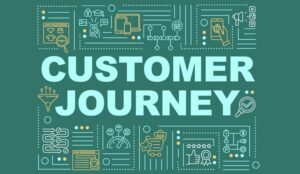When it comes to your business, nothing matters more than your customers. Your growth depends on current customers coming back for more purchases and converting first-time buyers.
But with an increasingly competitive landscape and ever-evolving customer expectations, retaining existing customers and attracting new ones means more than great prices or awesome products.
It takes having an exceptional digital customer experience to delight and support along every stage of the customer journey.
How important is digital customer experience for today’s customers? In a report from PwC, 73% of customers say CX is the number one thing they consider when deciding whether to purchase from a business.
In the fifth edition of the Salesforce State of the Connected Customer report, 94% of customers said that a positive customer experience increased the likelihood of repeat purchases from a brand.
Delivering digital customer experiences that increase sales and reduce churn isn’t something that happens overnight. It takes research, planning and strategic thinking to ensure your customer experience can adapt to changing customer priorities and expectations.
Not sure where to get started? We’ve got you covered.
In this post, Five9’s Ruthie Carey defines what digital customer experience is, what it looks like in action and gives you five steps to help you build a winning digital customer experience.
What Is Digital Customer Experience?
Digital customer experience comprises all the online touchpoints a customer has with your business. These touchpoints run from the first moment a customer discovers your business to the purchase experience to customer service.
Whether you offer a service or physical products, some of the standard touchpoints of digital customer experience include:
- Visiting your website to learn about your brand and products or services.
- Browsing product details and purchasing products.
- Asking questions through an AI-powered or live chat tool.
- Requesting customer service or a product return.
- Adding a recommendation for a product or service after purchase.
- Any follow-up communications from making a purchase to receiving their order.
Both traditional customer experience and digital customer experience share three core components — discovery, engagement, and delivery.
Discovery is how customers can contact your company, from phone calls to email to social media. Next, engagement is how your customers interact with your agents, self-service tools, or chatbots.
Finally, delivery looks at the speed and consistency of how you respond to your customer interactions.
What Does an Ideal Digital Customer Experience Look Like?
The ideal digital customer experience will vary from company to company — but at its core, it’s designed to delight and build trust.
Doing this right means understanding what your customers need and delivering it in their chosen channel or channels.
According to the Salesforce State of Service Report, customers use an average of nine touchpoints as they move through their buying journey.
When it comes to digital customer experiences, these touchpoints can happen across your digital footprint, including your website, mobile application, SMS, social media, email, and phone.
Delivering exceptional digital customer experiences today means taking an omnichannel approach where you market, sell, and serve customers wherever they are and however they contact you. A customer may begin a support request in an email and then follow up using a website chat tool.
Customers expect your agents to be able to quickly pick up a conversation from wherever it left off and have the context to answer their questions.
While the digital customer experience has many touchpoints, the most critical is having a responsive and fast website that works across desktop and mobile devices.
Research has shown that a poorly designed or slow website can make your potential customers turn to another brand.
50% of customers in a survey by socPub said they stopped visiting a company’s website due to poor mobile performance — even if they were fans of the brand already.
Crafting a Winning Digital Customer Experience Strategy in 5 Steps
Providing a seamless digital customer experience is vital to building trust and connection with customers. Your digital customer experience strategy is more than the tools you choose or channels you offer — it is understanding what your customers need and designing an experience from their perspective.
Here are five steps you can use to build a digital customer experience strategy for your business.
Step 1: Understand Customer Needs and Preferences
First, talk to existing and potential customers about what they expect from their interactions with your brand. Every company has a unique customer base depending on its products or services.
It’s also important to remember that most customers aren’t thinking about touchpoints like your customer experience or marketing teams would.
They see the entire experience as one interaction, regardless of the how, when, or where of the individual touchpoints.
When it comes to your brand, it’s critical to remember that each customer also has their own preferences for how, when, and where they want to interact with your company.
It doesn’t matter how it gets solved. It just matters that it does. Hubspot’s “The Robot Revolution” reported that 40% of customers said it didn’t matter if an agent or chatbot solved their issue — as long it was solved quickly.
Step 2: Map Customer Journeys
A key way to discover your customers’ needs and preferences is by mapping the customer journey. The journey begins with a customer coming to your website or social channel and ends with the delivery of their order.
Mapping the journey from first sight to opening the box can help you understand where you need to invest in new technology, processes, or people.
You also need to understand what you’re doing today when it comes to digital customer experience. You’ll likely have some tools, teams, and processes in place to support your sales and marketing efforts.
Having an audit of what you’re doing now can help you identify any gap along the customer journey that you need to address.
One last tip — make time to go through your purchase and customer service experiences to understand what your customers are seeing.
Seeing first-hand what your customers experience can help you identify unexpected pain points along the journey.
Step 3: Choose the Right Software and Tools
When it comes to your digital customer experience strategy, it’s important to choose the right tool for the right job.
Every pain point identified in your customer journey mapping exercise has numerous software tools or processes that can solve them for your customers. Understanding what your customers expect can also influence what tools you choose.
For example, more customers are expecting to use AI-powered chat to get support than human agents. Gartner has predicted that by 2027, chatbots will become the go-to channel for customer service in a quarter of all businesses.
Customer needs and preferences will continue to change, so choosing tools that can change with them is crucial.
Software is an investment, and making the right choice can mean the difference between creating loyal customers and customers choosing your competition for better experiences.
Step 4: Personalize and Optimize Interactions
In the 2021 Twilio State of Personalization Report, 60% of consumers said they become repeat buyers when they have a personalized purchasing experience.
With digital customer experiences, you can use earned and first-party data to deliver a personalized experience — whether that’s for purchasing, returns, or getting support.
Personalization goes beyond knowing your customers’ names and purchase history. You can use social media posts, reviews, and other data to help agents provide tailored support. This data can also be used by AI-powered tools to provide optimized answers to questions.
For example, a customer who recently received an item starts a conversation with a chatbot. The chatbot can use this data to predict the context of the conversation and ask the customer whether they need to return the specific item or offer them a link to a self-service portal for the item.
Step 5: Collect and Analyze Data for Continuous Improvement
You’re creating a living digital customer experience strategy that needs to evolve with your customers and business.
Your strategy needs to include a plan for what metrics you’ll use to evaluate your performance, how you’ll collect those metrics, and how you’ll make changes in the future.
Digital customer experience metrics can include:
- Customer retention rates
- Cart abandonment rates
- Customer Satisfaction Score (CSAT)
- Customer Effort Score (CES)
- Monitoring social media interactions
- Net Promoter Score (NPS)
All of these metrics feed into a cycle of continuous improvement. Adjusting your digital customer experience in real time can help reduce customer churn and reputation damage.
Embracing Innovation to Delight Your Customers
Implementing an amazing digital customer experience strategy means embracing innovative technologies and processes.
From AI chatbots to omnichannel support platforms, choosing the right technology means understanding what your customers need and what capabilities your current technology can deliver.
When you understand your constraints — whether it’s with data, tools, or people — you can choose the technology that will help your customers along every stage of their journey. Ready to take your digital customer experience to the next level?
This blog post has been re-published by kind permission of Five9 – View the Original Article
For more information about Five9 - visit the Five9 Website
Call Centre Helper is not responsible for the content of these guest blog posts. The opinions expressed in this article are those of the author, and do not necessarily reflect those of Call Centre Helper.
Author: Five9
Published On: 17th Oct 2023 - Last modified: 9th Dec 2024
Read more about - Guest Blogs, Five9






 Five9 empowers organizations to create hyper-personalized and effortless AI-driven customer experiences that deliver better business outcomes. Powered by Five9 Genius AI and our people, the Five9 Intelligent CX Platform is trusted by 3,000+ customers and 1,400+ partners globally. The New CX starts here and it's at the heart of every winning experience.
Five9 empowers organizations to create hyper-personalized and effortless AI-driven customer experiences that deliver better business outcomes. Powered by Five9 Genius AI and our people, the Five9 Intelligent CX Platform is trusted by 3,000+ customers and 1,400+ partners globally. The New CX starts here and it's at the heart of every winning experience. 































